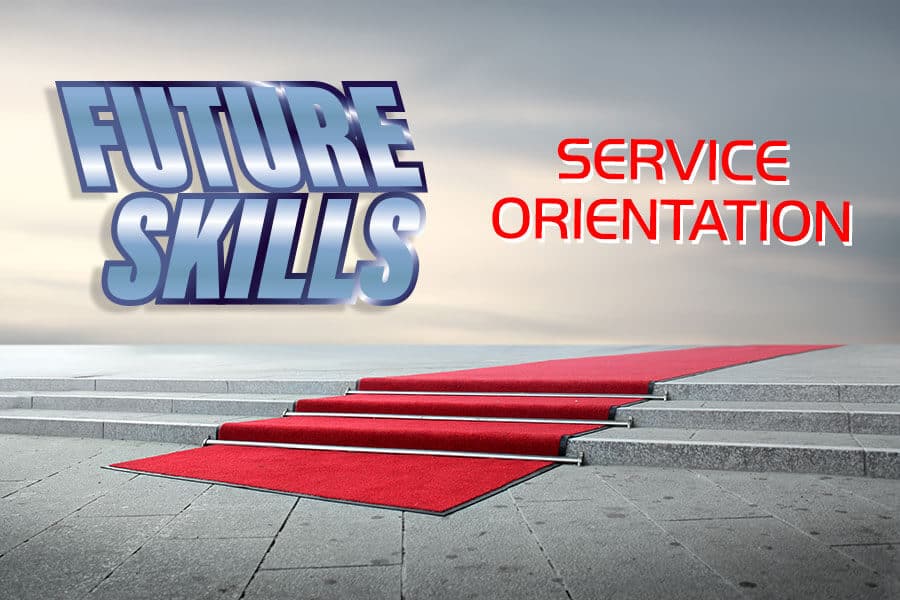The main rule of business: “A happy customer is a repeat customer.” Whether you are starting a small business or you work with clients, develop these skills and strategies to boost your sales and provide a competitive customer experience. With the rise of automation comes the rise of soft skills. According to the World Economic Forum Future of Jobs report, service orientation is amongst the top 10 skills that will help you to stay competitive in the workforce of 2020.
What is Service Orientation?
Service orientation was first described by researchers Saxe and Weirtz as being related to a concern for others. Later, the definition expanded to include a willingness to treat co-workers and clients with courtesy, consideration, and tact, communicate effectively, and perceive a customer’s needs.
The principles of service orientation include recruiting customer-friendly people and providing them with sufficient training, working with customers’ feedback, developing a quality product, and responding promptly and respectfully to consumer complaints and queries.
And whether you are starting a small business or you work with clients, in the era of personal brand-driven sales, you will benefit from knowing and applying a few customer-oriented techniques as described below.
Use Positive Words
Just as important as positive thinking is for health, so is positive talk important for customers. In addition to visible, non-verbal signals, it is important to convey a positive attitude towards customer’s needs through meticulously chosen positive words. Such an approach ensures that customers perceive themselves to be heard, cared about, and respected while their problems are being dealt with.

First of all, use positive action verbs. Instead of focusing on the negative connotation of verbs such as “don’t rush” and “don’t reject”, instead use synonyms such as “take your time” and “accept”. This will open up opportunities for further discussion. On a similar note, use subtle power words such as guaranteed, free, proven, and new to build a client’s trust in the product.
Certain words may bring about a feeling of being accused. For example, “you said” in some contexts may sound like passing blame on to someone – use “we previously spoke about” instead. Generally, it is advised to use “we” instead of “you” to show team effort of the customer and the seller.
The choosing of one’s words implies recognizing the inner strengths and limitations of their implications. And such details need to be taken into consideration when building rapport with customers.
Learn to Read Your Customers
To better understand the needs of your potential clients, first, it is important to create an ideal client profile. To do that, learn about the typical problems your competitors solve and find the areas in which you can provide a better service. After determining the demographics of your audience, ask for actual feedback by conducting interviews, hosting events, or sending out online surveys to take in exchange for a small value gift or a discount.
Now that you’ve established your audience, you will be ready to anticipate the problems individual clients may bring to you. At this stage you will benefit from knowing certain character profiling techniques to help you determine your client’s typical behavioral traits and help uncover hidden needs. Some of these techniques including creating a baseline for typical actions and comparing the chosen words with the character traits listed in this Forbes article. Additionally, The People Code by Dr. Taylor Hartman will guide you through four core motives that drive people (power, intimacy, peace, and fun) and will talk about people’s strengths and limitations.
Knowing personality types will allow you to adjust to each client; however, when it comes to reacting to client complaints, you need to have a good action plan up in your sleeve.
Keep Cool Under Pressure

For the most part, customer complaints are not a personal accusation towards you but rather a complaint regarding the service quality. And although it can be hard to take yourself out of the equation, there are a few techniques that will help you to regain control of the situation quickly. Lydia Ramsey, a business etiquette and protocol expert, suggests using a simple ASAP technique, which has four key actions:
- Apologize for the problem the customer has encountered.
- Sympathize with them on a human level and validate their reaction of irritability.
- Accept responsibility for the problem and offer alternatives to resolving the situation.
- Prepare to take action, deliver a quality service, and provide a bonus for the inconvenience.
The final step is to document the incident and set the precedent for future complaints that may occur. This way you will see the trends in your customer service and won’t feel caught off-guard in the future.
When it comes to sales, customers shouldn’t feel forced into purchasing your product. The quality you’re providing should speak for itself to alleviate any doubts.
SPIN Closing Technique
To help customers speed up the decision process, consider applying the SPIN selling technique. SPIN stands for situation, problem, implication, and need-payoff. It was first introduced in 1989 by Neil Rackham, an author focusing on “consultative selling”, in his book Major Account Sales Strategy. The core principle of SPIN is building a meaningful relationship with the target client by asking questions in order to expose the needs of the client’s business. Rackham identifies four basic stages of every sale:
Opening – connecting with the customer
Investigating – figuring out how the product can help the buyer
Demonstrating capability – describing the features, advantages and benefits of the product
Obtaining commitment – achieving a pre-determined outcome of the conversation – order, continuation, or no-sale
To provide comprehensive information about your services, practice persuasion skills. These skills aim to build personal connections with customers and create a line of reasoning that will appeal to them depending on their unique situations.
Once you understand the motives of the client, offer limited choices of possible solutions that range in value, price, and commitment. An additional step to building rapport with potential clients is providing social proof in the form of testimonials from previous customers of different backgrounds to appeal to a wider audience.
The scarcity tactic can be used to indicate a limited supply of the product or a limited time for a good deal. This tactic triggers the fear of missing out and the urge to take action. Several companies are using this principle to boost sales. They focus customers’ attention on the potential missed opportunity, competition with other customers, and exclusiveness if the product is for members only.
Attentiveness, an ability to communicate clearly, and knowledge of the product are crucial components of the successful product. To build recognized branding and implement immaculate customer service, explore approaches to customer journey mapping with Branding and Customer Experience free Coursera course and integrate core values and goal-setting techniques from the Achieving Personal and Professional Success course into both your work and your life.
Photos: Shutterstock / Photomontage by: Martina Advaney
Check out the other articles in the series of Top Future Skills:
Support us!
All your donations will be used to pay the magazine’s journalists and to support the ongoing costs of maintaining the site.
Share this post
Interested in co-operating with us?
We are open to co-operation from writers and businesses alike. You can reach us on our email at [email protected]/[email protected] and we will get back to you as quick as we can.










